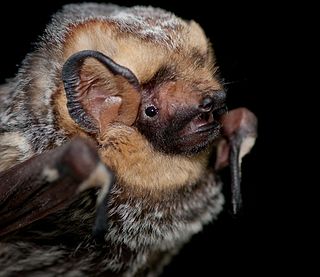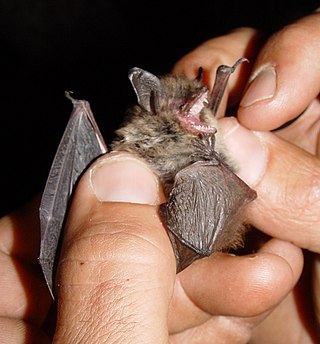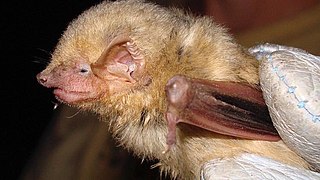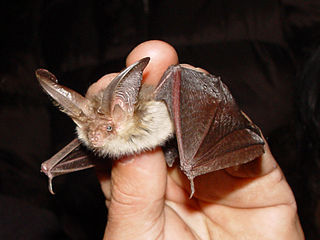
Vespertilionidae is a family of microbats, of the order Chiroptera, flying, insect-eating mammals variously described as the common, vesper, or simple nosed bats. The vespertilionid family is the most diverse and widely distributed of bat families, specialised in many forms to occupy a range of habitats and ecological circumstances, and it is frequently observed or the subject of research. The facial features of the species are often simple, as they mainly rely on vocally emitted echolocation. The tails of the species are enclosed by the lower flight membranes between the legs. Over 300 species are distributed all over the world, on every continent except Antarctica. It owes its name to the genus Vespertilio, which takes its name from a word for bat, vespertilio, derived from the Latin term vesper meaning 'evening'; they are termed "evening bats" and were once referred to as "evening birds".

Lasiurus is a genus of bats in the family Vespertilionidae. Its members are known as hairy-tailed bats or red bats.

The mouse-eared bats or myotises are a diverse and widespread genus (Myotis) of bats within the family Vespertilionidae. The noun "myotis" itself is a Neo-Latin construction, from the Greek "muós and "oûs", literally translating to "mouse-eared".

The hoary bat is a species of bat in the vesper bat family, Vespertilionidae. It lives throughout most of North America.

The big red bat is a species of vesper bat from South and Central America.

Eptesicus is a genus of bats, commonly called house bats or serotine bats, in the family Vespertilionidae. The genus name is likely derived from the Greek words ptetikos 'able to fly' or petomai 'house flier', although this is not certain.

The eastern red bat is a species of microbat in the family Vespertilionidae. Eastern red bats are widespread across eastern North America, with additional records in Bermuda.

The Hawaiian hoary bat, also known as ʻōpeʻapeʻa, is a species of bat endemic to the islands of Hawaiʻi. Whereas the mainland hoary bat is found throughout North America, the Hawaiian hoary bat is distributed only among the major volcanic islands of Hawaiʻi, making it the only extant and native terrestrial mammal in the state; although some studies also posit that the mainland hoary bat lives in sympatry on the Hawaiian Islands alongside the Hawaiian hoary bat, this has been disputed. The Hawaiian hoary bat was officially named the state land mammal of Hawaiʻi in 2015. It is a federally listed endangered taxon of the United States.

The western yellow bat is a species of vesper bat found in Mexico and the southwestern United States. This species roosts in trees such as Populus fremontii, Platanus wrightii, and Quercus arizonica. If available, the western yellow bat will use the dead fronds that encircle palm trees as a roosting site.

The silver-haired bat is a solitary migratory species of vesper bat in the family Vespertilionidae and the only member of the genus Lasionycteris.

The Vespertilioninae are a subfamily of vesper bats from the family Vespertilionidae.

The cinnamon red bat is a species of bat in the family Vespertilionidae. It was first described from a specimen that had been collected in Chile. For more than one hundred years after its initial description, it was largely considered a synonym of the eastern red bat. From the 1980s onward, it was frequently recognized as distinct from the eastern red bat due to its fur coloration and differences in range. It has deep red fur, lacking white "frosting" on the tips of individual hairs seen in other members of Lasiurus. It has a forearm length of 39–42 mm (1.5–1.7 in) and a weight of 9.5–11.0 g (0.34–0.39 oz).

The western red bat or desert red bat is a species of microbat in the family Vespertilionidae. It is found in western North America and Central America.

Aeorestes is a proposed genus or subgenus of vesper bat currently recognized as Lasiurus, commonly known as the hoary bats.

Dasypterus is a genus of or subgenus of vesper bat. As a genus, it includes species that were formerly in the genus Lasiurus. Collectively, members of Dasypterus are referred to as the yellow bats.

Perimyotini is a tribe of bats in the family Vespertilionidae. It contains two species of bats found in North America, each in their own monotypic genus.

Plecotini is a tribe of bats in the family Vespertilionidae. It contains several genera found throughout the Northern Hemisphere, in Eurasia, North Africa, and North America. Several genera in this tribe are known as big-eared bats or long-eared bats. It also contains the spotted bat and barbastelles.

Vespertilionini is a tribe of bats in the family Vespertilionidae. The largest of the tribes in Vespertilioninae, it contains many genera found throughout the Old World and Australasia.

The long-tailed myotis is a species of vesper bat found in northern and eastern Asia.

















